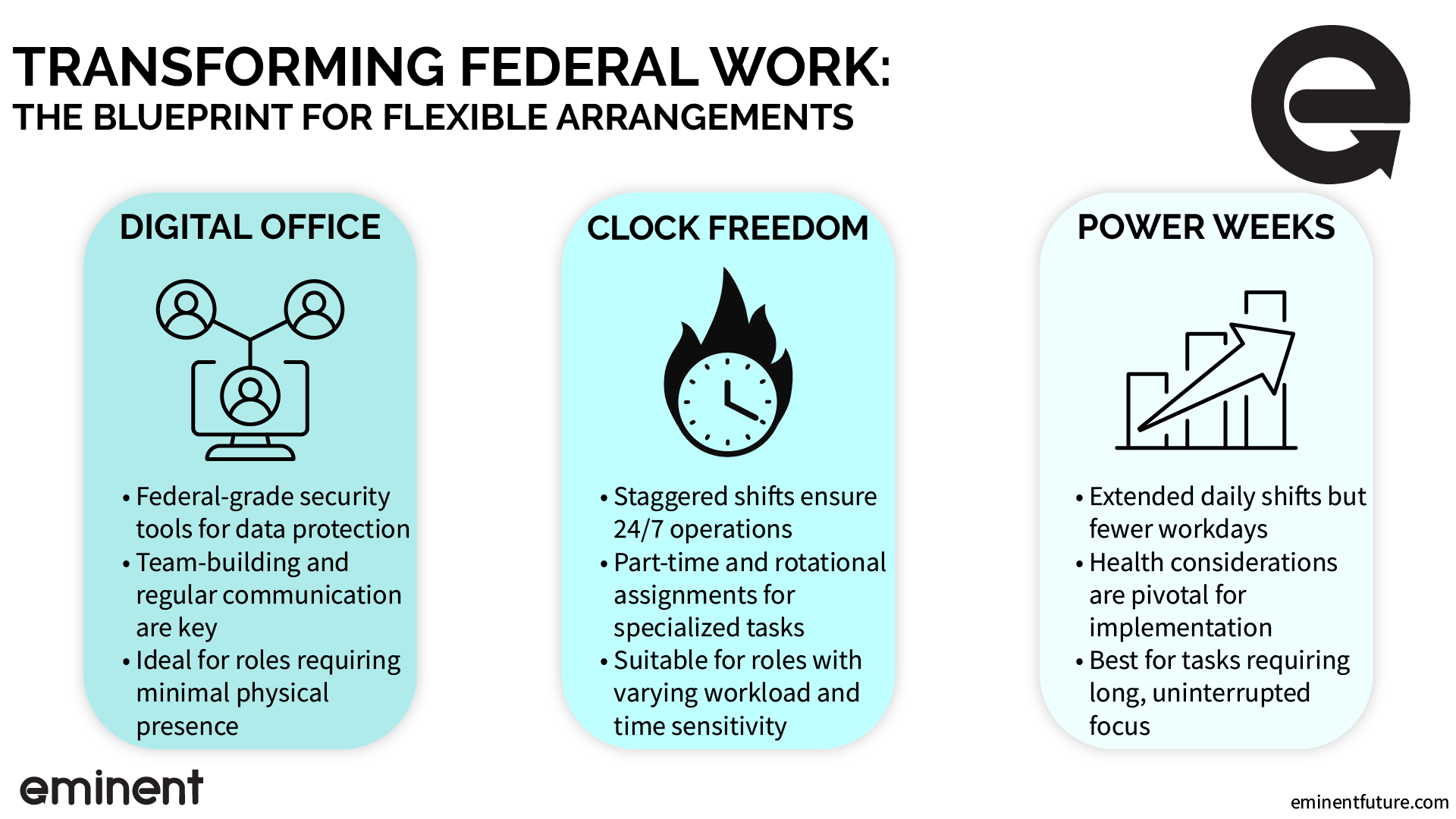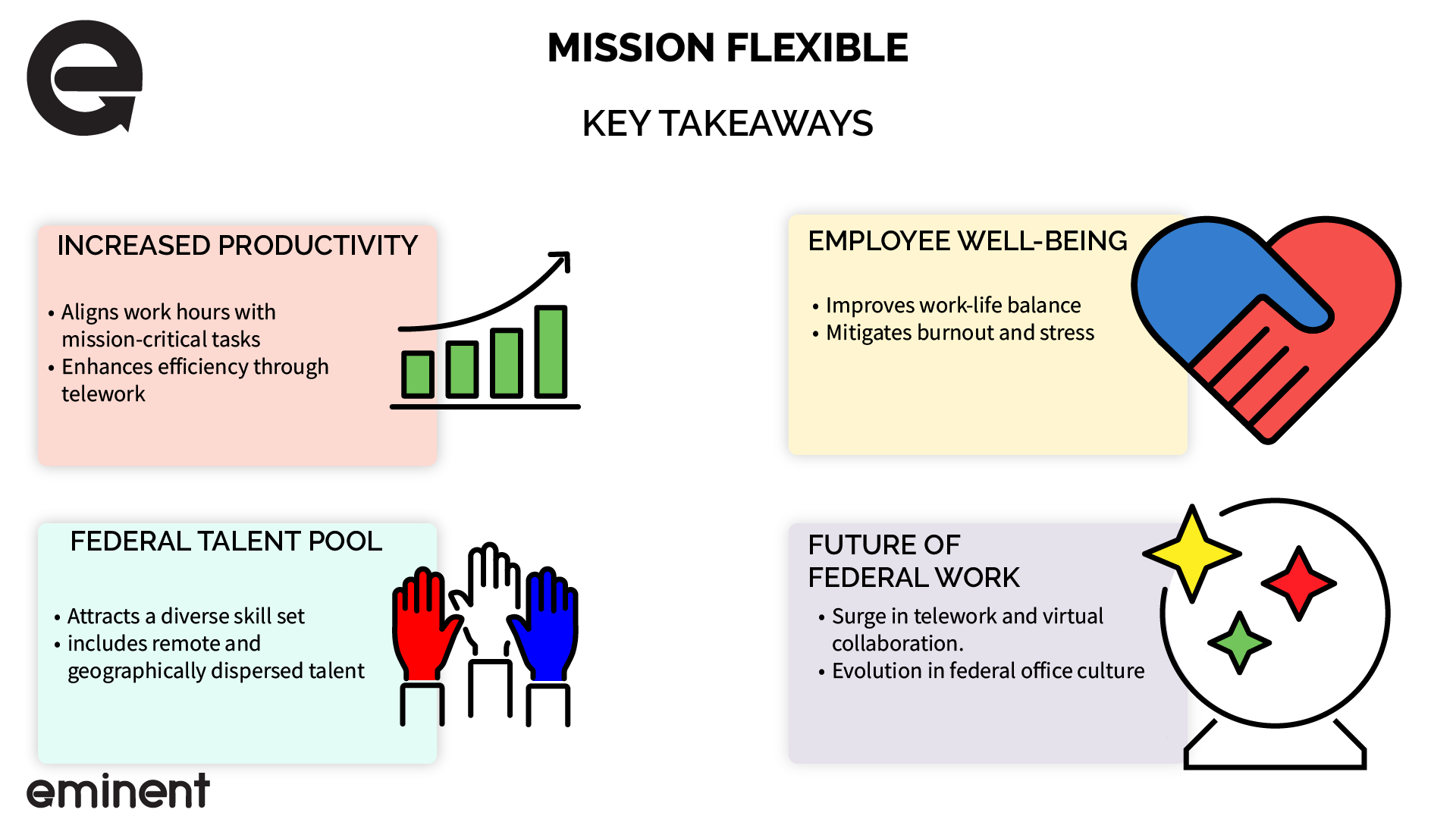In an era where the work landscape is rapidly evolving,
federal agencies face a pivotal moment to rethink their traditional work
schedules. This article embarks on a comprehensive exploration of flexible work
arrangements and how they can redefine productivity and well-being in the
public sector.

Flex Work 101: Public Sector Edition
Flexible work arrangements refer to various forms of work schedule flexibility that deviate from the traditional 9-to-5 model. Within the public sector, these can include telework, flexible scheduling, part-time assignments, and compressed work weeks. These work modalities offer federal employees the latitude to tailor their work schedules to align with mission-critical tasks, individual well-being, and broader societal needs.
The 9-to-5 Legacy in Federal Jobs
The 9-to-5 work schedule has its roots in the Industrial Revolution and later became the standard for most white-collar jobs, including roles within federal agencies. This fixed schedule was initially designed to optimize factory operations and later became the status quo for office work. Federal agencies, often slow to adapt to workforce innovations, have mostly adhered to this traditional work model, tying employees to fixed hours and locations.
Why Uncle Sam Needs a Schedule Revamp
The nature of work in federal roles has evolved, particularly with the advent of technology, so it needs more adaptable work arrangements. Today’s federal roles often require flexibility that the rigid 9-to-5 schedule cannot offer.
Whether it’s a cybersecurity expert monitoring threats around the clock or emergency management teams responding to crises at all hours, the scope and demands of public service roles have fundamentally changed. These developments underscore the need for federal agencies to modernize their work schedules to meet contemporary challenges more effectively.
Can Flex Work Fit Our Federal Needs?
This article evaluates the viability and benefits of implementing flexible work arrangements within federal agencies. Specifically, we will explore how such structures can increase productivity, improve employee well-being, and attract a diverse talent pool while also looking at the types of flexibility most suitable for different federal roles. We will also examine federal agencies’ challenges in this transition and present case studies showcasing the successful implementation of flexible work policies.
The Upsides of Flexibility: Why Federal Agencies Win
In the modern public service landscape, agencies are testing the traditional work model to its limit. Flexible work arrangements are a powerful tool for federal agencies to improve performance, employee well-being, and talent diversity. Below, we delve into these three key benefits, exploring how flexible work schedules can serve as a win-win solution for federal agencies and their employees.

The Productivity Boost: Serving Better, Faster
When it comes to optimizing public service, every hour counts. A flexible scheduling approach can significantly increase productivity by matching employee work hours with the tasks that matter most.
Aligning Work Hours with Mission-Critical Tasks
Flexible work schedules allow federal employees to align their most productive hours with the most crucial aspects of their work. For instance, cybersecurity personnel can be scheduled during high-risk periods, while administrative tasks can be relegated to off-peak hours. This alignment maximizes individual output and ensures they can handle mission-critical tasks with optimal focus and efficiency.
Leveraging Telework for Peak Performance
Telework isn’t just about convenience; it’s a strategic tool to boost public service efficiency. Commute-free days reduce employee fatigue, leading to more energetic and focused staff. Also, the quiet of a home environment can be conducive to tasks requiring deep concentration, thereby enhancing productivity levels.
Happy Feds, Better Service: Well-being Takes Center Stage
Workplace well-being has evolved from a ‘nice-to-have’ to a ‘must-have,’ especially in high-stress roles often found in federal agencies. By focusing on employee well-being through flexible work arrangements, agencies can build a more resilient and content workforce.
Achieving Work-Life Harmony in Stressful Roles
Federal jobs often come with their share of stress, from tight deadlines to emergency responses. Flexible work arrangements offer an essential respite, allowing employees to juggle work demands with personal needs better. Whether picking up kids from school or attending a weekday appointment, the increased flexibility helps maintain a healthier work-life balance.
Curbing Burnout, One Flex Hour at a Time
Burnout is an unfortunate reality in high-stress public service roles. Offering employees a choice in how and when they work can drastically reduce the risk of burnout. By giving them the power to manage their work schedules, federal agencies also empower them to manage their stress levels more effectively.
Casting a Wider Net: Diversifying the Federal Workforce
The quest for talent has never been more critical or complex. Flexible work arrangements offer federal agencies a significant edge, enabling them to attract a wide range of skills and experiences that may have previously needed to be within reach.
Skill Hunting: Beyond Geographic Boundaries
One of the most striking benefits of flexible work arrangements is tapping into a diverse skill set not limited by geography. Whether it’s an environmental scientist in Hawaii or a data analyst in Vermont, federal agencies can now recruit the best talent for the job, regardless of their physical location.
Remote Inclusion: Expanding the Talent Pool
The potential to include remote or geographically dispersed talent not only broadens the range of skills available but also enriches the diversity of the federal workforce. From single parents who need a flexible schedule to military spouses who move frequently, various individuals can contribute their unique perspectives and skills to the federal service through flexible work arrangements.
Tailoring Flexibility: Work Models for the Federal Landscape
Flexibility isn’t a one-size-fits-all solution, particularly for complex federal operations with distinct mission objectives. To implement flexible work arrangements effectively, agencies must identify the types that align best with their needs. In this section, we explore three main types of flexible work arrangements most compatible with federal agencies.

Digital Office: The Future is Telework
As federal agencies navigate an increasingly digital world, telework emerges as a viable and essential option for many roles.
Secure Tech: The Backbone of Federal Telework
Telework in the federal sector requires robust, secure technological tools to protect sensitive data. Federal-grade security features like VPNs, multi-factor authentication, and encrypted communications are paramount. These tools enable remote work to be as secure as traditional in-office work, ensuring the integrity of federal operations.
Remote Yet Connected: Building Team Unity
Maintaining a cohesive and connected workforce is crucial, especially when teams are geographically dispersed. Virtual team-building exercises, regular video conferences, and effective communication platforms can help cultivate a sense of unity among remote federal workers.
Clock Freedom: Redefining the 9-to-5
Flexible scheduling can be the key to keeping federal operations running smoothly around the clock without compromising employee well-being.
Shift Ingenuity: 24/7 Federal Operations
Staggered shifts can provide continuous coverage for federal agencies responsible for essential services. For example, emergency response teams or cybersecurity units may benefit from flexible scheduling that always ensures trained professionals are on duty.
Bite-Sized Roles: Part-Time and Rotational Assignments
Flexible scheduling isn’t just about daily hours; it also encompasses part-time or rotational roles. These arrangements can be particularly beneficial for specialized tasks or projects that don’t require a full-time commitment but do require technical skills.
Power Weeks: When Less is More
Compressed workweeks are another way federal agencies can offer flexibility while maintaining high-performance levels. These models might be particularly appealing for roles requiring long, uninterrupted, focused work spans.
Peak Performance in Extended Shifts
Compressed workweeks often involve longer daily shifts but fewer workdays, allowing for three- or four-day weekends. This schedule can increase productivity, as employees may find it easier to focus during extended work periods without interrupting a daily commute.
The Health Equation: Compressed Weeks and Worker Well-Being
While compressed workweeks can enhance productivity, it’s vital to consider the potential health impacts. Extended shifts may lead to fatigue or stress if not managed well. Therefore, building adequate rest periods and monitoring employee well-being is crucial.
Roadmap to Flexibility: Implementing Flexible Work in Federal Agencies
Agencies must have a robust action plan before any form of flexibility can become a part of the federal work landscape. This section explores key steps in successfully implementing flexible work arrangements in federal agencies.

Mission Check: Aligning Flexibility with Federal Goals
Understanding the mission and objectives of each federal agency is the first step in considering any sort of work flexibility. Agencies must assess which flexible work options are most conducive to fulfilling their mission-critical tasks.
Policy Blueprint: Crafting Clear Guidelines
For flexible work to function efficiently, transparent policies governing telework and flexible scheduling need to be implemented by management. These policies should outline eligibility criteria, expected performance levels, and the resources available to federal employees.
Skill Shift: Upskilling the Federal Workforce
As work modalities change, so must the skills of both managers and employees. Agencies should invest in training programs to upskill staff to operate effectively within the new work structures. Topics could range from effective remote communication to time management skills.
Team Sync: Ensuring Cross-Agency Collaboration
One of the challenges of flexible work arrangements is the potential impact on inter-agency communication and collaboration. Mechanisms should be in place to ensure that all agencies can work together seamlessly, irrespective of differing work schedules.
Performance Lens: Continuous Assessment and Tweaking
Once implemented, supervisors should continually monitor the efficiency of flexible work arrangements. Agencies must be ready to adjust their policies based on performance metrics, employee feedback, and evolving federal objectives.
Navigating Roadblocks: Challenges and Solutions in the Federal Context
Even the best plans come with their own sets of challenges. Federal agencies face unique hurdles when it comes to implementing flexible work arrangements in the public sector. This section will dissect these challenges and propose solutions tailored to the federal work environment.

Puzzle Pieces: Unpacking the Complexities of Government-based Flex Work
Flexible work arrangements can create complexities that are particularly challenging in a governmental setting, ranging from cross-agency communication to data security and privacy concerns.
Cross-Agency Communication Nuances: Federal work often involves multiple agencies, and flexible schedules complicate this interplay. When employees across agencies are working asynchronous hours, there can be lags in communication and decision-making.
Data Security and Privacy Concerns: As employees shift towards telework and remote working setups, agencies must grapple with protecting sensitive information. An ad-hoc approach can put crucial data at risk.
Steering Through Storms: Overcoming Federal-Specific Challenge
Fortunately, these challenges are not insurmountable. With strategic planning and execution, agencies can overcome these hurdles and thrive in a flexible work setting.
Inter-Agency Collaboration Forums: Establishing formalized platforms for communication can ease the cross-agency challenges. This might be regular inter-agency video conferences, collaboration tools, or shared dashboards that update all parties in real-time.
Federal-Grade Security Measures and Training: When it comes to data security, more than a one-size-fits-all approach will be required. Federal agencies should invest in specialized security software and comprehensive training programs tailored for remote and flexible work scenarios.
Living Proof: Case Studies of Federal Agencies Nailing Flex Work
While flexible work arrangements may seem daunting to some federal agencies, those are leading the pack and setting a standard for others to follow. This section dives into real-life case studies where federal agencies have successfully implemented flexible work options and reaped the benefits.

Trailblazers: Federal Entities Leading the Flex Revolution
Some federal entities are well ahead of the curve when it comes to taking the plunge into the world of flexible work. Below are agencies that have not just adopted but thrived in the flexible work ecosystem:
- Internal Revenue Service (IRS): This tax-collecting behemoth reported that in 2022, over 70% of its employees enjoyed flexible work options, ranging from partial to full-time telework. Their initiative has increased productivity, employee morale, and retention rates. 1.
- Department of Veterans Affairs (VA): In 2021, the VA launched a new initiative, “VA Flex,” to broaden the range of flexible work options available to its employees, including telework, compressed workweeks, and staggered work hours. 2.
- Department of Defense (DOD): The DOD is rolling out a flexible work policy allowing employees to work from home two days a week. This policy aims to attract and retain top talent, and there are plans for future expansions 3
Golden Standards: Best Practices for Public Service
Learning from the experiences of these agencies can offer insights into best practices that can guide other federal entities in their quest for workplace flexibility.
- Social Security Administration (SSA): The SSA has been running a pilot program, “SSA Flex,” that allows employees to telework up to two days per week. The program is under evaluation for its effectiveness, with the possibility of broader implementation if successful. 4.
More Reading
To learn more about these case studies in flexible work arrangements, check out these links!
- Internal Revenue Service (IRS). “IRS Telework.” IRS.gov, 2023, irs.gov/about-irs/irs-telework.
- Department of Veterans Affairs (VA). “VA Flex.” VA.gov, 2023, va.gov/opa/press-releases/va-flex.
- Department of Defense (DOD). “DOD Announces New Flexible Work Policy.” DOD News, 2023, defense.gov/News/Article/Article/2985696/dod-announces-new-flexible-work-policy/. ↩
- Social Security Administration (SSA). “SSA Flex Pilot Program.” SSA.gov, 2023, ssa.gov/benefits/flex/index.html.
The Road Ahead: Future Trajectories of Flexible Work in Federal Sectors
As we consider the future of work in the public sector, it’s clear that flexibility will play an increasingly significant role. From technology adoption to shifting workplace cultures, federal agencies are poised for change. This section explores the anticipated trends and their implications for federal work environments.

The Digital Wave: Predicted Surge of Telework and Virtual Collaboration
As tools for remote work become more sophisticated and secure, the adoption of telework will likely continue to soar. The rise of virtual collaboration platforms will make it easier for federal employees to work seamlessly from different locations. This won’t just be a phenomenon limited to crises or special situations; it’s expected to become the norm.
Culture Shift: Evolving Office Culture within Federal Institutions
The flexibility trend will also have a profound impact on office culture. Hierarchical structures may become more flattened as employees at all levels become accustomed to remote collaboration. We’ll also likely see a greater emphasis on results-oriented performance metrics rather than time spent in a physical office space.
Urban Implications: Impact on Federal Infrastructure and Commute Patterns
The repercussions of a flexible work model extend beyond the office walls. Reduced reliance on physical office spaces could lead to downsizing federal buildings and facilities, leading to cost savings. Similarly, easing daily commutes could alleviate traffic congestion in city centers where federal offices are located, thereby impacting urban planning and sustainability initiatives.
As federal agencies increasingly adapt to flexible work arrangements, we will likely see ripple effects extending from individual employee well-being to broader societal impacts. This evolution promises an exciting, dynamic future for the federal workforce.
Embracing Flexibility as the Future of Federal Work

As we navigate the complexities of modern work environments, the call for flexibility within federal agencies has never been more pressing. Throughout this article, we’ve explored the compelling benefits of flexible work arrangements—from enhanced productivity and employee well-being to broadening the federal talent pool. We’ve also delved into the types of flexibility most suitable for different federal roles, acknowledging the challenges and offering solutions tailored to the unique needs of the public sector.
From early adopters like the IRS and the Department of Veterans Affairs to emerging pilots within the Department of Defense and the Social Security Administration, there’s growing evidence that flexible work policies can succeed within federal contexts. Yet the journey toward universal flexibility has its roadblocks. It requires meticulous planning, from policy formulation and technological enablement to employee training and ongoing performance assessment.
Looking ahead, we can anticipate that flexible work arrangements will persist and evolve. Advances in technology, shifts in office culture, and broader urban implications are all on the horizon. The future is promising and leans toward a more flexible, adaptive, and resilient federal workforce. The ultimate goal is a public sector that is both effective and human-centered, meeting its missions’ needs while respecting the needs of its most valuable asset—its people.
By embracing flexible work arrangements, federal agencies are not just keeping pace with the modern world but also investing in a more productive, satisfied, and diversified workforce. And in doing so, they set a precedent for what the future of work can and should look like, both within the government and beyond.



